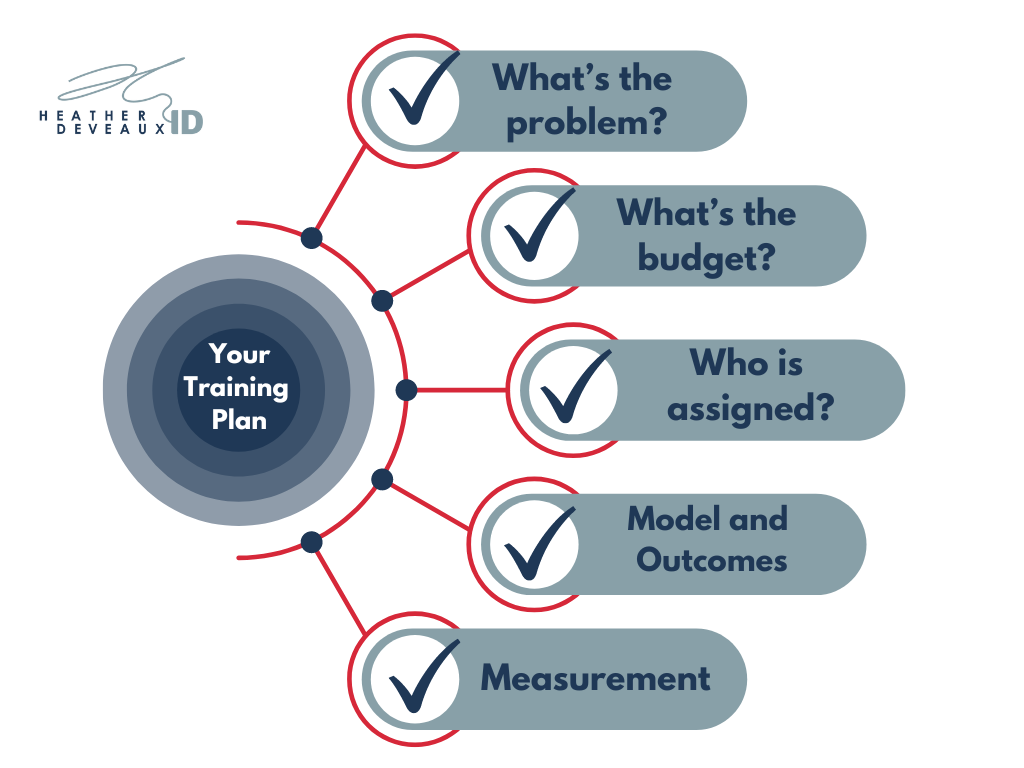How to Create a Training Plan in Your Company
Creating a training plan doesn’t have to be overwhelming.
You’re probably hearing a lot of noise about planning a year of social media posts right now. It’s the marketer’s show right now, to be sure. Oh, and the fitness gurus. Can’t forget them: new year, new you! But what about your training plan for 2024? Sure, you might be planning to create training initiatives in the new year, but have you thought about how to actually make that happen? Like all things in life and business, it starts with having the right kind of plan.
What stinks?
I wish I had better news than to tell you do to yet another needs analysis for your company’s educational roadmaps, but creating a solid plan starts with knowing where the gaps are. But I’ll make this fun for you: where did people drop the ball this year? Including yourself. Ouch, I know. Go ahead and celebrate the wins: it’s a great time of year for that too. But if you want to get to the heart of the problem, ask yourself where things fell through the cracks.
Small improvements over time seem to have the longest-lasting impact from a learning perspective: don’t ask your people to do too much all at once. Give them time to learn the skills you’re teaching and set clear, measurable outcomes for them to work toward. If an initiative falls short, it gives you a clear starting point to determine what skills need to be improved for next time.
Sidenote: gaps analysis, needs analysis, whatever you want to call it, is not meant to provide evidence for punitive action. Far from it: in fact, it’s meant to provide a clear understanding of what training initiatives should be the priority.
Here’s an example: Let’s say your team didn’t meet their year-end sales goals. It’s common. Very common, actually. We shoot for the moon and land amongst the stars all the time in business. But it doesn’t feel so uplifting when it’s happening to your company, does it? Rather than bark about how sales teams need to do better, talk to them about where they feel like they could use support. What tools were missing from their toolbox? What interactions caused them the most stress? This information can help you build your training plan.
Simple, yet effective questions can help instructional designers like myself determine what training priorities need to be. What’s more, using that information, we can design training plans for organizations that build on the most important skills and gaps, and continue to refine those over time while building more skills and closing more gaps.

What’s the budget?
It’s difficult for organizations to know how much money to spend on training initiatives, especially with the rising cost of literally everything. Rather than bring in outside expertise to offer training and then disappear with all of their proprietary frameworks and systems, I always recommend companies create in-house training.
I recommend in-house training for three reasons.
First, your company pays ONCE for the development and creation of the training material and then you can use it over and over again.
Second, you own and control the rights to the material so you can change and update it as needed, rather than having to go through an expensive gatekeeper.
Third, you have access to your own data and can track changes and improvements over time. This information helps you see the next gap set and so on.
But how much does it cost to work with an instructional designer?
Great question. When you consider the cost of bringing in a subject matter expert to meet your training plan needs and deliver training to your organization, it can cost upwards of $100,000 depending on the size of your organization. But then, they take their subject matter expertise and go on their merry way. Which means, you’re left hiring another subject matter expert for the next thing.
Working with an experienced instructional design to assess, create, develop and deliver your training materials can cost far less. In fact, for less than the cost of one annual salary in your training department, you can have a fully functioning, ready-to-deliver online or in-person training course for your organization to use again and again. Prices in my company start at $25,000 per project and I offer scale pricing for larger, ongoing projects.
Who delivers the content?
Another great question about your training plan. If you’re skipping the part where you hire a subject matter expert to come in and deliver training to your organization, who delivers it? This can happen in several ways.
First, you can participate in the creation process and create videos that can be uploaded into the online course.
Second, you can request a train-the-trainer package for your in-person delivery system that allows you to train in-house facilitators (I can also help with that!) and be fully in charge of delivering your own training systems.
And third, you can work with me to create a hybrid system where you designate one or two existing employees to provide coaching, support, facilitation, etc. to accompany online learning options.
Need help developing an in-house coaching program or facilitator program? I can help with that too.
What does your training schedule look like?
Rather than get caught off guard halfway through 2024 when things fall short, choose one area you know can be improved through training and development initiatives and commit to delivering that. And if you’re not sure where to focus, I can assist with a needs assessment in short order.
A good rule of thumb to create your training plan is to plan for one training initiative per quarter. This allows enough time to create the project, roll it out, and begin collecting data for refinement in the next quarter. Start with one area for improvement and build on it from there.
What’s the best source of information for determining your training needs?
Your people. Hands down. Don’t assume you know what the problems are. Ask. Better yet, hire a professional instructional designer to ask the right questions and present the information back to you. (Fun fact: this is part of the creation process when you hire me – no extra charge).
Do you really need to develop training?
Yes. Your employees need continuous training and support. Don’t skimp on this part of your company’s growth plans. It can make all the difference to an employee when their employer invests in them and sees potential in their work.






